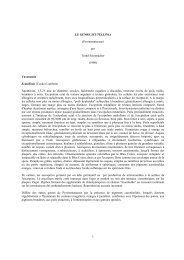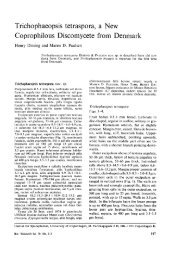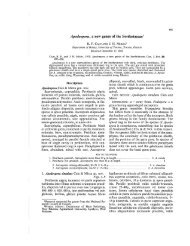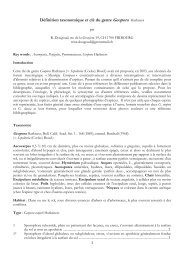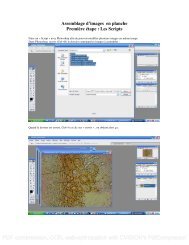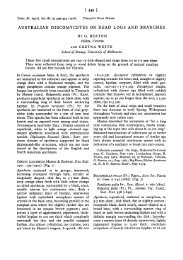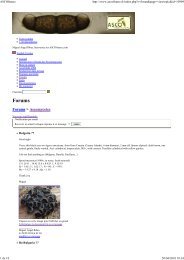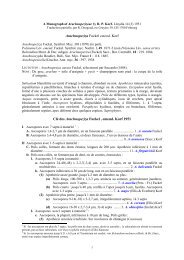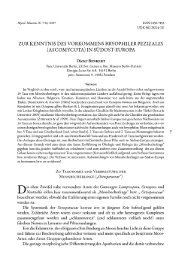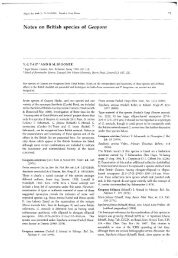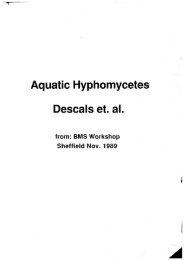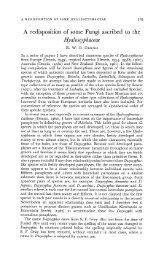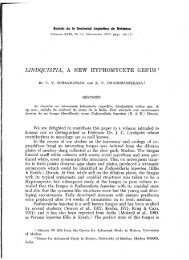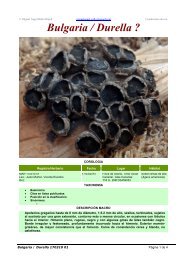Stray Studies in the Coronophorales (Pyrenomycetes) 4-8 - ASCOfrance
Stray Studies in the Coronophorales (Pyrenomycetes) 4-8 - ASCOfrance
Stray Studies in the Coronophorales (Pyrenomycetes) 4-8 - ASCOfrance
Create successful ePaper yourself
Turn your PDF publications into a flip-book with our unique Google optimized e-Paper software.
324 J. A. NannfeldtSpores obliquely uniseriate or biseriate, 1-septate, fusiform to ellipsoidal, hyal<strong>in</strong>e, th<strong>in</strong>walled,6-7x 1.5-2 p.m.N. stictarum is evidently a parasite kill<strong>in</strong>g <strong>the</strong> attacked parts of <strong>the</strong> host. Alsoo<strong>the</strong>r fungi may be responsible for <strong>the</strong> necroses and <strong>the</strong> blacken<strong>in</strong>g of <strong>the</strong> apo<strong>the</strong>ciaand thallus parts as it is not rare to f<strong>in</strong>d two or more parasymbionts and parasitessimultaneously attack<strong>in</strong>g a lichen thallus. However, <strong>in</strong> <strong>the</strong> Sticta specimens with N.stictarumno o<strong>the</strong>r fungus could be identified.Our fungus is very easily overlooked on account of its m<strong>in</strong>ute peri<strong>the</strong>cia, whichare as dark as <strong>the</strong> substrate. When collect<strong>in</strong>g specimens of Sticta lichenologists try toavoid <strong>the</strong> partly dead specimens <strong>in</strong> which <strong>the</strong> fungus grows. However, some samplesof <strong>the</strong> new fungus were found <strong>in</strong> lichen herbaria.The hosts of AT. stictarum so far known, viz. Sticta ambavillaria (Ach.) Bory andSt. tomentosa(Sw.) Ach., are two closely related species which seem to have ra<strong>the</strong>rsimilar ecological requirements. On <strong>the</strong> East African mounta<strong>in</strong>s <strong>the</strong> parasite seemsto be common <strong>in</strong> wet forests and bushlands from 2 500 to 3 500 m s.m.DISTRIBUTION: Most probably widely distributed <strong>in</strong> tropical regions. At presentknown from East Africa and South America.Africa (all f<strong>in</strong>ds on St. ambavillaria): Kenya: Central Prov.: Mt. Kenya, W. slope, NationalPark Road (Naro Moru Track), bamboo zone, alt. 2700-3 100 m, on Arund<strong>in</strong>aria alp<strong>in</strong>a,23.i. 1970 R. Santesson 22144 f (Type). SW. slope, upper part of bamboo zone, 6.ii. 1922 R. E. &Th. C. E. Fries 4024 b (UPS). E. slope, Urumandi, alt. 3 100 m 1959 M. J. Coe (UPS). — Mt.Aberdare, along Wandera's Track, alt. 3 300 m, on Stoebe kilimandarica, 15.vii. 1971 I. & O.Hedberg 5024 1 (UPS).Tanzania: Arusha Prov.: Mt. Meru, E. slope, road to <strong>the</strong> crater, alt. 1900 m, on a big tree <strong>in</strong><strong>the</strong> montane forest, 7.Í.1971 R. Santesson 23073 b (UPS). E. slope, ca. 2 km N. of KitotoCamp, alt. 2450 m, on Stoebe kilimandscharica and Hypericum lanceolatum <strong>in</strong> dense Ericaceousbushland, 7.i. 1971 R. Santesson 22960, 22969 (UPS). — Kilimanjaro Prov.: Mt. Kilimanjaro,W. slope, E. of Lemosho Glades, Ericaceous zone, alt. 2800-2900 m, on various shrubs,14.i. 1970 R. Santesson 21297 a (UPS).South America (both f<strong>in</strong>ds on St. tomentosa): Peru: Dept. Puno: Sachapata, ix.1854 W.Lechler (parasitic on Plantae peruv. 3124; UPS).Brazil: Estado Paraná: Rio Negro 9.x. 1908 P. Dusén (S)."8. The "Nitschkia Group" <strong>in</strong> EuropeMy studies <strong>in</strong> <strong>the</strong> Scand<strong>in</strong>avian herbaria and <strong>in</strong> some o<strong>the</strong>rs have revealed 6 speciesof this group to occur <strong>in</strong> <strong>the</strong> Nordic countries and two more <strong>in</strong> West and SouthEurope, one of which (AT. confertula) should be sought for <strong>in</strong> south-westernScand<strong>in</strong>avia. The floristic literature is <strong>in</strong>sufficient to recognize <strong>the</strong>m, and—as shown<strong>in</strong> Chapt. 2—<strong>the</strong>ir nomenclature has been badly confused. Fitzpatrick's wellfoundeddist<strong>in</strong>ction between <strong>the</strong> two species that had both passed as N. cupularishas astonish<strong>in</strong>gly been neglected by all subsequent European writers.SvenskBot. Tidskr. 69 (1975)



